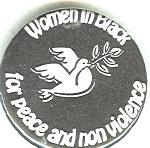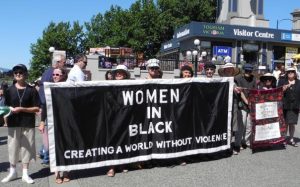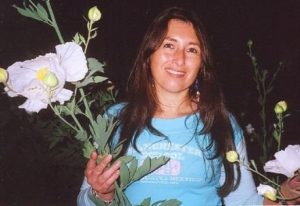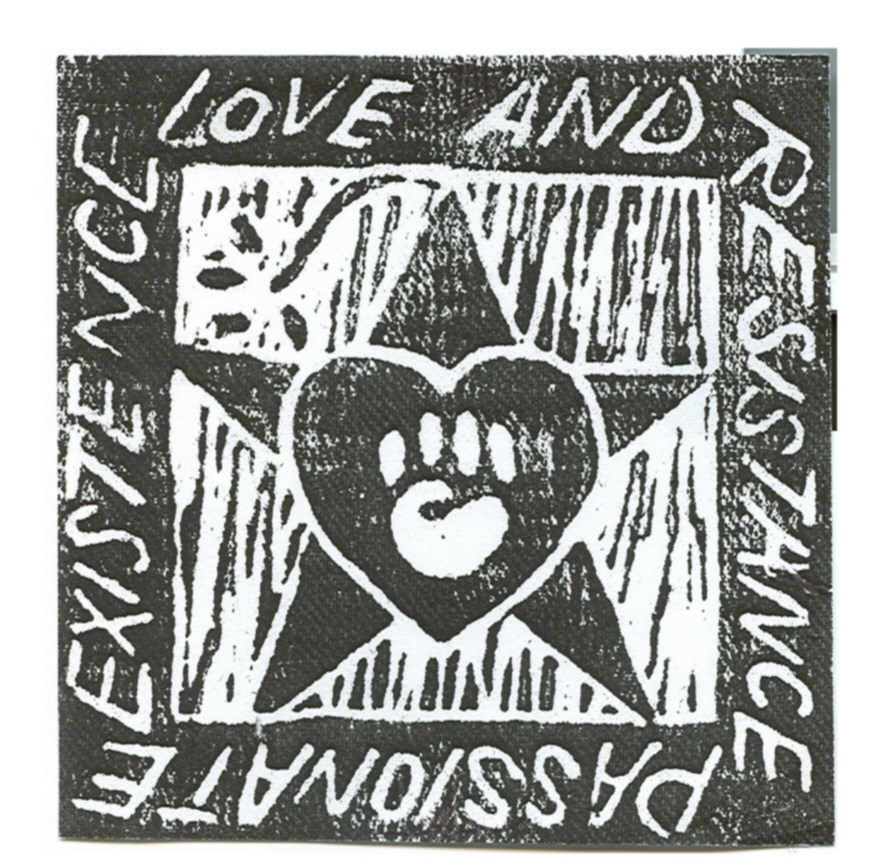 VICTORIA WOMEN IN BLACK started in October 1995 after Theresa Wolfwood returned from the Beijing Women’s Forum where she attended the WIB demonstration there. Victoria WIB has met since then in silent vigil, usually beside City Hall on the edge of Centennial Sq. on one Thursday a month, at noon. We hold a large banner made by several members of the group.
VICTORIA WOMEN IN BLACK started in October 1995 after Theresa Wolfwood returned from the Beijing Women’s Forum where she attended the WIB demonstration there. Victoria WIB has met since then in silent vigil, usually beside City Hall on the edge of Centennial Sq. on one Thursday a month, at noon. We hold a large banner made by several members of the group.
In August we hold our Hiroshima-Nagasaki remembrance vigil on the sidewalk beside the Tourist office –across from the Empress Hotel. Over the year a pattern has emerged in our vigils. We hand out a different leaflet every vigil. Vigillers do not respond to passersby & try to maintain silence; the person handing out leaflets can answer question & listen to comments, but we do not engage in argument or discussion. Supportive men are welcome at our vigil.

Many are for special occasions- March, International Women’s Day where we have noted violence against women (including Canadian 1st Nations women) & other issues on women’s rights that remain unresolved; May, Mother’s day for Peace –the original meaning of day as a day of action for women to end war, not a day for flowers & cards; Hiroshima-Nagasaki, noting Canada’s participation in providing uranium for bombs. We pass out white poppies & a bookmark with information on the significance of the poppy in November. In December we sometimes celebrate Human Rights Day &/or ethical gift giving for Xmas. Our leaflets always include action suggestions with names & addresses.
Over the years issues presented in leaflet have covered – Colombian human rights abuses & Canada’s connection to that country; opposing wars in Iraq, Palestine, Afghanistan & Yugoslavia; also opposing Canadian participation in those wars & military action in Libya & the possibility in Syria. We write about economic violence – the poverty of marginalized people in Canada – homeless, disabled, 1st Nations – and draw attention to growing economic inequality in Canada. We document the rise in our military budget as social services are cut. We have written about creating a culture of peace & the need for more support for education.

In October we alerted people to the $1B. which our government wants to spend on drones & how we would spend that amount. We make suggestions for where to buy fair trade products, how to become involved in social movements locally, supporting grassroots initiatives like Occupy & Idle No More & other peace & justice groups. Victoria WIB has a Face Book page on which we post upcoming events & the contents of our current leaflet. We maintain contact locally with a list serve & also have contact with Calgary WIB.

Victoria WIB also participates in other events- like the annual Earth Walk & recently the demo against Canadian participation in military action in Syria. We make decisions after the monthly vigil & by Email.
We welcome people who spontaneously join us when they see us & also many visitors from around the world have joined us from a UK MP to a Guatemalan women’s activist.
History of “WOMEN IN BLACK” globally
“Women in Black” is a women’s anti-war movement with an estimated 10,000 activists around the world. The first group was formed by Israeli Jewish & Arab women in Jerusalem in 1988, following the outbreak of the First intifada.
Responding to what they considered serious violations of human rights by Israeli soldiers in the Occupied Territories, the women held a vigil every Friday in central Jerusalem, wearing black clothing in mourning for all victims of the conflict. Many local WIB groups made contact with women across the Green Line engaged in support work, e.g. visiting Palestinians in Israeli prisons.
The initiative soon spread to various other locations in Israel, with women standing weekly in main squares of cities or at junctions on inter-city highways. As was decided early on, the movement did not adopt any formal program other than opposition to the occupation. Local groups were autonomous in deciding such issues as whether or not to open participation to men as well as women, and there were many shades of political difference from one place to another.
The first vigils in other countries were started in solidarity with the Israeli group, but then embraced other social and political issues. Especially notable were the Women in Black group in former Yugoslavia, which in the 1990s confronted rampant nationalism, hatred and bloodshed, often meeting with violence from nationalists.
While each group is free to pursue its own goals and activities, the women maintain regular contact via e-mail and the Internet, and hold annual international conferences. Their most common tactic consists of standing together periodically in various public places, usually in complete silence.
“Women in Black” was inspired by earlier movements of women who demonstrated on the streets, making a public space for women to be heard – particularly Black Sash, in South Africa, and the Madres de la Plaza de Mayo, seeking the “disappeared” in the political repression in Argentina. But WIB also shares a genealogy with groups of women explicitly refusing violence, militarism and war, such as the Women’s International League for Peace and Freedom formed in 1918, and the Greenham Common Women’s Peace Camp in the UK and related groups around the world opposing the deployment of US missiles in the eighties.
In other countries, including Canada, the USA, Australia, and many European countries, Women in Black groups started. Italian women founded their own WIB, Donne in Nero, which soon had weekly vigils in Roma, Milano, Bologna, Torino, Ravenna, Padova and Verona. Large numbers of women from Italy have maintained a programme of visits to Israel/Palestine for more than a decade.
Soon after, when Yugoslavia began to disintegrate and war broke out between the former Yugoslav republics, some of the Italian women visited feminist activists in Belgrade, which led to a similar form of organization and action there. Women in Black in Belgrade (Zene u Crnom) was formed in 1991. Explicitly feminist, they have been actively opposing nationalist aggression and masculine violence ever since. Zene u Crnom had a strong and challenging street presence, with regular weekly vigils in Republic Square in Belgrade from 1991. They work in partnership with men refusing to serve in the military, and have maintained an extensive programme involving public statements, writing and publishing, educational workshops and seminars, and organizing international visits and meetings.
A Spanish WIB network, Mujeres de Negro, were by now strong and active. They helped find refuge, respite and a public platform in Spain for women from the Yugoslav region. It was with an important input from Mujeres de Negro and Donne in Nero that the women of Zene u Crnom in Belgrade organized a series of ten annual international encounters at different locations in the former Yugoslavia, which have been an important force creating and expanding the international network.
During the sequence of wars that began in 1992, in Croatia and Bosnia., Women in Black groups sprang up in many more countries, supporting Zene u Crnom Belgrade in their opposition to nationalist aggression. Women got together in Belgium (a French-speaking group Femmes en Noir in Brussels and Flemish-speaking group Vrouwen in het Zwart in Leuven). Women in Black London took its name at this time, starting to hold weekly or monthly vigils in Trafalgar Square, in central London. Women in Black in India began in 1992. When the Babri Masjid, an ancient mosque, was torn down by Hindu fundamentalists and violence engulfed India, women were the main victims. WIB in the city of Bangalore have stood every Thursday in silent vigils on the streets, in the market squares and in the Gandhi Peace Park, protesting the wars against women.
Women in Black in the Philippines began in 1995. The Asian Women’s Human Rights Council and the Lila Pilipina, an organization of former comfort women, gather often in front of the Japanese Embassy in Manila, dressed in black, demanding compensation for the wartime crime of sexual slavery by the Japanese army in World War II. A landmark occasion in the nineties was a massive Women in Black vigil (an estimated 3000 women) in Beijing on September 4 1995 that was organized by the Women in Black of India and the Asian Women’s Human Rights Council, at the time of the UN World Conference on Women. They called for “a world safer for women” and an end to wars and armed conflicts. From 1996, Women in Black in Nepal have stood in silent vigils around the issues of trafficking and violence against women in public places in Katmandu. Women in Black meets in Kashmir, calling for a peaceful settlement of conflict there – which is just beginning to happen.
In 1998 and 1999 Women in Black groups everywhere had occasion to demonstrate against a sequence of military engagements by the USA, sometimes partnered by the UK, or in the context of NATO. These included continued sanctions and bombing raids against Iraq, the bombing of Sudan and Afghanistan, and the bombardment of Belgrade and other Serbian cities. Groups of women, primarily from Donne in Nero but also from London WIB and elsewhere have been visiting Palestine and Israel since the start of the al-Aqsa intifada to support Palestinians and strengthen links between them and Israeli women peace activists.
The Asian Women’s Human Rights Council and El Taller International, two networks of women’s human rights organizations in the global south, have held seventeen Courts of Women in different regions and vigils of Women in Black have been held before each Court. There was a very intense and creative demonstration of over 5000 women in Cape Town, South Africa, on the eve of the World Court of Women Against War, For Peace (March 2001). The Women in Black in South Africa stood against war and for peace. Women in Black is present at World Social Forums; in Mumbai Indian WIB organized a panel on war & conflict resolution.
Women in Black in Victoria were thrilled to see that a genuine winner of the Nobel Peace Prize, as Nobel stated it was to awarded to those who worked for peace between nation, was chosen in 2017. The International Campaign to Abolish Nuclear weapons was awarded the prize and Setsuko Thurlow, a friend of our women in black members was chosen to accept the award. Setsuko, a Hiroshima survivor has worked for decades for peace and nuclear disarmament has lived in Toronto for 60 years. .
Women in Black locally and internationally have received a number of awards in recognition of their work for peace. The worldwide network was awarded the Millennium Women’s Peace Prize sponsored by the NGO International Alert and the UN agency UNIFEM, and the following year the network was a nominee for the Nobel Peace Prize. Donne in Nero were awarded the Gold Dove of Peace, an Italian prize, in 2002. The Network was honoured by Church Women United, USA .

————————————————————————————————–
Theresa Wolfwood 2017


